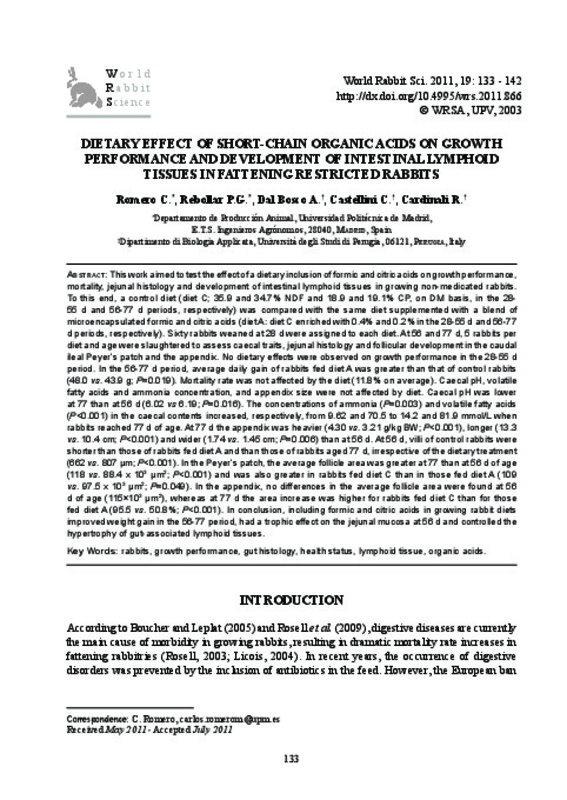JavaScript is disabled for your browser. Some features of this site may not work without it.
Buscar en RiuNet
Listar
Mi cuenta
Estadísticas
Ayuda RiuNet
Admin. UPV
Dietary effect of short-chain organic acids on growth performance, mortality and development of intestinal lymphoid tissues in young non-medicated rabbits
Mostrar el registro sencillo del ítem
Ficheros en el ítem
| dc.contributor.author | Romero, Carlos
|
es_ES |
| dc.contributor.author | García Rebollar, Pilar
|
es_ES |
| dc.contributor.author | Dal Bosco, Alessandro
|
es_ES |
| dc.contributor.author | Castellini, Cesare
|
es_ES |
| dc.contributor.author | Cardinali, Raffaella
|
es_ES |
| dc.date.accessioned | 2011-10-19T12:49:54Z | |
| dc.date.issued | 2011 | |
| dc.identifier.issn | 1257-5011 | |
| dc.identifier.uri | http://hdl.handle.net/10251/12208 | |
| dc.description.abstract | [EN] This work aimed to test the effect of a dietary inclusion of formic and citric acids on growth performance, mortality, jejunal histology and development of intestinal lymphoid tissues in growing non-medicated rabbits. For that purpose, a diet including the acids (diet A) was compared to a control diet (diet C). Sixty rabbits weaned at 28 days were submitted to each diet. At 56 and 77 days, ten rabbits were slaughtered to assess caecal traits, jejunal histology and follicular development in the caudal ileal Peyer's patch and in the appendix. In the 56-77 d period, average daily gain of rabbits fed diet A was greater than that of control rabbits (48.0 vs. 43.9 g, P=0.019). Mortality rate was not affected by the diet (6.12% on average). Caecal pH was lower at 77 than at 56 days (6.02 vs. 6.19, P=0.016). The concentration of ammonia in the caecal contents increased from 9.62 to 14.2 mmol/l (P=0.003) when rabbits reached 77 days of age. The appendix was heavier (9.75 vs. 4.30 g, P<0.001), longer (13.3 vs. 10.4 cm, P<0.001) and wider (1.74 vs. 1.45 cm, P=0.006) at 77 than at 56 days. Rabbits of 56 days of age fed diet C had shorter villi than the mean value of the other three treatments (662 vs. 807 µm, P<0.001). In the Peyer`s patch, the average follicle area was greater at 77 than at 56 days of age (118 vs. 88.4 x 103 µm2, P<0.001) and was also greater in rabbits fed diet C than in those fed diet A (109 vs. 97.5 x 103 µm2, P=0.049). In the appendix, no differences on the average follicle area were found at 56 days of age (115 x 103 µm2) whereas, at 77 days, the area increase was higher for rabbits fed diet C than for those fed diet A (95.5 vs. 50.8%, P<0.001). In conclusion, including formic and citric acids in growing rabbit diets improves weight gain, has a trophic effect on the jejunal mucosa and controls the development of gut-associated lymphoid tissues. | es_ES |
| dc.language | Inglés | es_ES |
| dc.publisher | Editorial Universitat Politècnica de València | es_ES |
| dc.relation.ispartof | World Rabbit Science | |
| dc.rights | Reserva de todos los derechos | es_ES |
| dc.subject | Fattening rabbits | es_ES |
| dc.subject | Growth performance | es_ES |
| dc.subject | Gut histology | es_ES |
| dc.subject | Health status | es_ES |
| dc.subject | Lymphoid tissue | es_ES |
| dc.subject | Organic acids | es_ES |
| dc.title | Dietary effect of short-chain organic acids on growth performance, mortality and development of intestinal lymphoid tissues in young non-medicated rabbits | es_ES |
| dc.type | Artículo | es_ES |
| dc.date.updated | 2011-10-18T13:13:11Z | |
| dc.identifier.doi | 10.4995/wrs.2011.866 | |
| dc.rights.accessRights | Abierto | es_ES |
| dc.description.bibliographicCitation | Romero, C.; García Rebollar, P.; Dal Bosco, A.; Castellini, C.; Cardinali, R. (2011). Dietary effect of short-chain organic acids on growth performance, mortality and development of intestinal lymphoid tissues in young non-medicated rabbits. World Rabbit Science. 19(3):133-142. https://doi.org/10.4995/wrs.2011.866 | es_ES |
| dc.description.accrualMethod | SWORD | es_ES |
| dc.relation.publisherversion | http://doi.org/10.4995/wrs.2011.866 | |
| dc.description.upvformatpinicio | 133 | |
| dc.description.upvformatpfin | 142 | |
| dc.description.volume | 19 | |
| dc.description.issue | 3 | |
| dc.identifier.eissn | 1989-8886 | |
| dc.identifier.eissn | 1989-8886 | es_ES |








